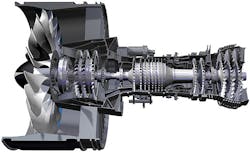High-Frequency Spectroscopy Analyzes Thermal Barrier Coatings
High frequencies on the scale of gigahertz and terahertz are useful for non-destructive testing and evaluation of opaque materials like ceramics and concrete. Changes in the refractive index of light at these frequencies as it passes through a material can indicate how a material deforms, or other properties including dielectric coefficients.
Scientists from Heriot-Watt University in the UK apply the technology to analyze thermal-barrier coatings (TBCs) used on turbine blades and on other components used in jet engines. According to the paper released in the Optical Society journal, TBCs usually consist of four layers—a super alloy substrate (typically nickel or cobalt based), a bond coat, a thermally grown oxide (TGO) layer, and a ceramic top coat. Yttria-stabilized zirconia (YSZ) is a common ceramic that is used.
The THz GhZ optical analysis was used to perform strain analysis of TBCs, and create models of their behavior over time to accurately predict their service life. The method shines gigahertz frequency light through an opaque ceramic coating on a metal part. A periscope is used to measure changes in the light’s refractive index as strain is applied to the part. The refractive index, or bending of light as it is transmitted through the material, can indicate how the material changes.
“Our strain-measurement technique can analyze the coatings immediately after manufacturing and work to identify the turbine blades that would last the longest in the airplane. Ultimately, we want to develop an imaging device that would show the strain distribution in the coating of an entire turbine blade, information that would be used to decide if that turbine blade would go into service,” explains researcher Andrew J. Moore.
Testing was conducted using a piece of metal sprayed with the same ceramic coating used on Rolls Royce turbine blades. To improve the method’s spatial resolution, the researchers are exploring higher frequency illumination in the terahertz range. They also want to make strain measurements of ceramic-coated metal samples.
“We will be looking to see when the coatings fail and then correlating that with GHz and THz measurements we took prior to the aging process,” says Moore. “This is a step toward using our technique to identify which coatings fail first.”
About the Author
Leah Scully
Associate Content Producer
Leah Scully is a graduate of The College of New Jersey. She has a BS degree in Biomedical Engineering with a mechanical specialization. Leah is responsible for Machine Design’s news items that cover industry trends, research, and applied science and engineering, along with product galleries. Visit her on Facebook, or view her profile on LinkedIn.
